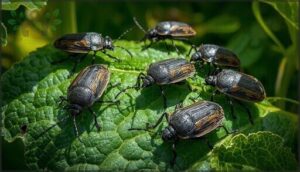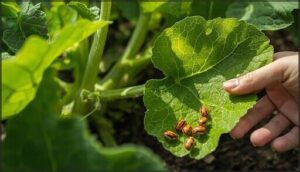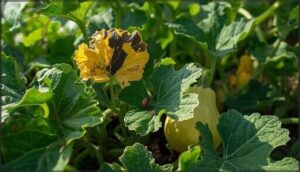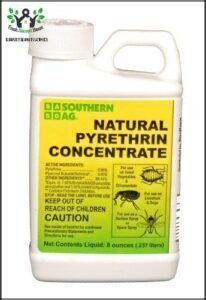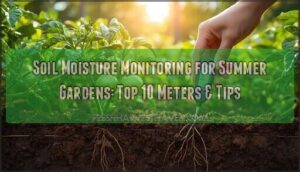This site is supported by our readers. We may earn a commission, at no cost to you, if you purchase through links.
You might not realize squash bugs are in your garden until you spot wilted, yellowing leaves on your healthiest plants. These persistent pests pierce plant stems and drain essential fluids, leaving behind damaged vines that struggle to produce fruit.
The challenge isn’t just eliminating the bugs you see—it’s stopping their rapid reproduction cycle before an infestation takes hold.
Fortunately, you don’t need harsh chemicals to protect your squash plants. A combination of hands-on removal, natural sprays, and smart prevention strategies can effectively manage squash bugs while keeping your garden organic and your soil healthy.
Table Of Contents
- Key Takeaways
- How to Identify and Spot Squash Bugs
- Effective Natural Remedies for Squash Bugs
- Organic Prevention and Management Strategies
- Top 5 Natural Products for Squash Bug Control
- Frequently Asked Questions (FAQs)
- Does vinegar kill squash bugs?
- How do you get rid of squash bugs naturally?
- What plants repel squash bugs?
- How do you get rid of squash bugs at night?
- How do I protect my squash plants from pests?
- Does neem oil kill squash bugs?
- What time of year do squash bugs appear?
- How long do squash bugs live?
- Can squash bugs fly or just crawl?
- Do squash bugs attack indoor squash plants?
- Conclusion
Key Takeaways
- Squash bugs drain plant fluids through piercing mouthparts and reproduce rapidly, but you can identify them by their shield-shaped bodies, bronze egg clusters on leaf undersides, and the yellow-to-brown wilting damage they leave behind.
- Handpicking bugs into soapy water achieves an 87% success rate, while natural treatments like neem oil, insecticidal soap, and diatomaceous earth target nymphs effectively when applied consistently every few days.
- Prevention strategies like row covers, resistant varieties (especially Cucurbita moschata types like butternut), trap crops such as Blue Hubbard squash, and thorough fall cleanup cut infestations by 70-85% without chemicals.
- Combining multiple tactics—removing eggs with duct tape, using companion plants like nasturtiums and radishes, and checking plants every 3-4 days during peak season—delivers the most reliable long-term control.
How to Identify and Spot Squash Bugs
Before you can fight squash bugs, you need to know what you’re looking for. These pests have distinct features that set them apart from other garden insects, and catching them early makes all the difference.
Let’s break down how to recognize squash bugs at every stage so you can take action fast.
Physical Characteristics of Squash Bugs
Adult squash bugs measure 0.55–0.63 inches long with dark grayish-brown to black coloration. You’ll notice their shield-shaped bodies are distinctly flattened, about one-third as wide as their length.
Bug identification becomes easier when you spot these features:
- Alternating orange or gold stripes along the abdomen edges
- Wings folded flat in an X-pattern across the back
- Black legs and antennae throughout all life stages
They emit an unpleasant odor when crushed. They’re known to feed by sucking the sap out of leaves.
Squash Bug Eggs and Nymphs
Once you’ve spotted the adults, check leaf undersides for eggs. Squash bug eggs appear bronze to brick red, laid in diamond-shaped clusters of 15 to 40. They hatch in 7 to 10 days under typical conditions.
Newly emerged nymphs show red heads with light green abdomens, maturing through five stages over four to six weeks. Squash bugs use piercing-sucking mouthparts to feed on host plants.
Remove eggs immediately—handpicking prevents entire generations from establishing.
Signs of Squash Bug Damage
Identifying squash bug damage early protects your harvest. Within one to two weeks of feeding, you’ll notice yellow spots on plant leaves that expand into dry, brown edges. Watch for these leaf symptoms:
- Wilting leaves turning black and crispy
- Stippling and irregular nutrient loss patterns
- Vine collapse in severe cases
- Fruit damage with sunken, scarred areas
Heavy infestations can destroy entire plants by mid-summer.
Squash Bug Look-Alikes and Differentiation
Several bugs mimic squash bugs in your garden. Brown marmorated stink bugs have shield-shaped bodies and white wing overlaps, while squash bugs show elongated oval shapes with brown wings. Leaf-footed bugs display distinctive leaf-like expansions on hind legs that squash bugs lack.
Check for copper-colored squash bug eggs versus the pearly white eggs of stink bugs. Nymph coloration differs too—squash bug nymphs turn gray then brown, while stink bug nymphs stay green.
Effective Natural Remedies for Squash Bugs
Once you’ve spotted squash bugs on your plants, it’s time to take action before they multiply and cause serious damage.
The good news is that several natural control methods work well when applied consistently throughout the growing season.
Here’s a rundown of the most effective techniques you can start using today to protect your squash plants.
Handpicking and Drowning in Soapy Water
When you’re dealing with a squash bug invasion, handpicking paired with drowning in soapy water delivers an 87% success rate.
Handpicking squash bugs and drowning them in soapy water achieves an 87% success rate against infestations
Mix 1–2 tablespoons of liquid soap per gallon of water, then drop bugs into the solution—they’ll die within four minutes as soap disrupts their protective coating.
Check your plants every 3–4 days, targeting mornings when bugs are sluggish and visible.
Using Insecticidal Soap Sprays
Insecticidal soap sprays target nymphs effectively when you apply 1–2 tablespoons of liquid soap (Castile or dish soap) per gallon of water directly onto bugs. Spray early morning or late evening to protect pollinators and minimize leaf burn. These biodegradable solutions break down quickly, so reapply after rain.
Adult squash bugs resist soap better than nymphs, making early action important for control.
Neem Oil Applications
Neem oil is a natural squash bug control method that disrupts feeding and reproduction when mixed at a rate of 2 tablespoons per gallon of water and sprayed weekly in the evening. This solution kills eggs and nymphs by preventing molting, although adults show greater resistance.
Application frequency and technique are crucial—ensure leaf undersides are thoroughly coated, as this is where eggs often hide. Neem oil’s environmental impact remains minimal because it breaks down quickly in sunlight, making it an ideal choice for organic pest control within integrated management plans.
Applying Diatomaceous Earth
Diatomaceous earth works like tiny shards of glass against squash bugs, dehydrating nymphs through microscopic cuts in their exoskeletons. This natural pest control method delivers up to 74% reduction in nymph populations when applied correctly.
For effective organic pest control, follow these guidelines:
- Dust around plant bases and stems on dry, sunny days for maximum soil application contact
- Reapply after wet weather every 24-72 hours since moisture eliminates effectiveness immediately
- Focus plant coverage on leaf undersides and entry points where squash bugs congregate
- Wear a mask during application frequency as safety measures against respiratory irritation
- Combine with handpicking for better results against resistant adults
This natural remedy remains active only while dry, so vigilant reapplication becomes your key to success.
Setting Up Homemade Squash Bug Traps
Simple boards become your best allies in squash bug control. Place wooden boards measuring 0.91 by 0.61 meters between crop rows, then check them each morning when trap board placement works best.
You’ll find 20-40 bugs hiding underneath wet trap efficiency traps in heavily infested gardens. Cardboard newspaper traps work too, catching 12-18 bugs per setup.
Combined trap strategies with soapy water drowning reduce populations by 42% over six weeks.
Removing Eggs With Duct Tape
Duct tape turns egg removal into a quick morning routine that actually works. You’ll capture over 90% of visible squash bug eggs with each gentle swipe across leaf undersides, and a single roll handles 12-15 plants all season for under $5.
- Check leaves every 2-3 days during June and July when females lay up to 250 eggs each
- Press tape gently on bronze egg clusters, then peel slowly to avoid leaf damage
- Remove 20-30 eggs per cluster without harming delicate leaf tissue
- Seal used tape in trash immediately—detached eggs can still hatch in compost
- Combine with handpicking adults for 80% total population suppression
Organic Prevention and Management Strategies
The best defense against squash bugs is stopping them before they become a problem. Prevention takes less effort than fighting an active infestation, and it protects your plants from the start.
Here are six strategies that keep squash bug populations under control all season long.
Row Covers and Physical Barriers
Using row covers gives you direct control over preventing squash bug damage. These physical barriers—usually spunbond polypropylene or insect netting for plants—block adults from laying eggs while allowing over 80% sunlight through. Edge sealing matters; bugs slip under loose fabric.
Studies show yield increases of 46–54% in protected plots. Installation costs are offset by eliminating pesticide needs.
Remove covers at flowering for pollination, usually after 11–28 days.
Companion Planting to Repel Squash Bugs
Beyond barriers, certain companion plants act as natural repellents through scent and biological enhancement. Nasturtium efficacy is proven—field studies show 75% fewer egg clusters. Radish repellent strategies reduce populations up to 75% when planted one week before squash.
Marigold impact includes attracting predatory insects. Catnip deterrents work through volatile oils, while basil and tansy disrupt colonization.
These companion planting strategies support pest control without chemicals.
Planting Resistant Squash Varieties
Companion plants help, but resistant squash varieties give you even stronger protection. Cucurbita moschata types—like butternut squash and cheese pumpkins—naturally resist these pests through tougher vines and recovery mechanisms. Regional trials prove it:
- Green-striped Cushaw reduced bug survival substantially in Kansas tests
- Seminole Pumpkin maintained heavy yields under active pressure
- Butternut varieties consistently outperformed susceptible types
Breeding programs continue improving resistance, though no variety offers complete immunity.
Trap Crops for Squash Bug Control
If resistant varieties aren’t enough, trap crops offer you another powerful strategy. Blue Hubbard Squash planted along perimeters draws squash bugs away from your main cucurbit vegetables—studies show reductions up to 95%. Plant trap crops 1–2 weeks early for best results.
You’ll also protect against cucumber beetles, achieving multi-pest protection while cutting pesticide use through smart trap crop timing.
Garden Cleanup and Crop Rotation
When you clear all dead plant material and mulch in fall, you cut overwintering squash bug populations by up to 85%. Gardens with thorough fall debris removal see 70% fewer bugs the next spring.
Practicing crop rotation to non-cucurbits annually delivers a 67% drop in returning adults. This seasonal timing disrupts reproduction and delivers long-term effects—combined strategies reduce crop losses by 72%.
Monitoring and Breaking The Lifecycle
Tracking squash bug life cycle stages weekly through June, July, and August lets you catch adults, nymphs, and eggs when they’re most vulnerable. Removing squash bug eggs with duct tape eliminates 80% of clusters before hatching.
Breaking the squash bug lifecycle works best when you target nymphs—they’re easier to kill than adults. Intervention methods combined with trap cropping reduce populations by 70%.
Top 5 Natural Products for Squash Bug Control
You’ve learned the techniques—now let’s talk about the products that make them work. The right natural controls can turn the tide against squash bugs without harsh chemicals.
Here are five proven products that gardeners rely on to protect their crops.
1. Dawn Ultra Original Dish Soap Refill
Dawn Ultra Original Dish Soap is one of the most accessible homemade squash bug sprays you’ll find. Mix one tablespoon of this liquid soap per quart of water, and you’ve got an effective homemade spray that works on contact. The action mechanism is straightforward—dish soap breaks down the bugs’ protective coating, causing dehydration.
Application techniques matter: spray directly on squash bugs, focusing on leaf undersides where they hide. Plant safety requires proper dilution to avoid leaf burn.
Dawn’s insecticidal performance rivals commercial options, killing up to 90% of visible bugs within 24 hours.
Best For: Gardeners looking for an affordable, readily available solution to tackle squash bug infestations without buying specialized insecticides.
- Kills up to 90% of squash bugs within 24 hours when sprayed directly, with a simple 1 tablespoon per quart of water mixture that’s easy to make at home.
- Works on multiple garden pests including aphids, stink bugs, and whiteflies, making it a versatile option beyond just squash bugs.
- Contains biodegradable surfactants with no phosphates, so it breaks down naturally and won’t leave harmful residues in your garden soil when used at proper dilution.
- Requires direct contact to work, meaning you need to physically spray each bug and can’t rely on any residual protection after application.
- Can cause leaf burn or plant damage if you use too much or apply during hot midday sun, so timing and dilution need careful attention.
- Needs repeated weekly applications to keep infestations under control, which takes more effort than some commercial products that offer longer-lasting results.
2. Petra Organic Neem Oil for Plants
Petra Organic Neem Oil provides multi-layered protection against squash bugs without synthetic chemicals. This cold-pressed concentrate disrupts insect hormonal systems while acting as an antifeedant and growth regulator.
Mix 0.5–1 oz per gallon of water and spray every 7–14 days, targeting nymphs for best results. You’ll see noticeable population drops within two weeks. Apply in the evening to protect pollinators—neem oil is OMRI-listed for organic gardens, but contact can harm beneficial insects.
Its market growth reflects what organic growers already know: neem oil works.
Best For: Organic gardeners dealing with squash bugs, aphids, or Japanese beetles who want an eco-friendly pest control option and don’t mind a strong smell or evening application routines.
- Contains azadirachtin that disrupts insect hormones and feeding, with studies showing up to 90% mortality in immature pest stages when applied correctly.
- OMRI-listed and USDA organic-approved, making it safe for certified organic gardens with minimal environmental persistence (breaks down within two weeks).
- Versatile use across multiple plant types including roses, orchids, and smooth-leaved plants, plus helps control fungal issues like powdery mildew and black spot.
- Strong, unpleasant odor that many users find off-putting during and after application.
- Can harm beneficial insects including native pollinators if not applied carefully in the evening, limiting when you can safely spray.
- Not suitable for all plants (avoid calatheas and hairy-leaved varieties) and some users report packaging issues with oil spills during shipping.
3. Southern Ag Natural Pyrethrin Concentrate
Southern Ag Natural Pyrethrin Concentrate delivers rapid knockdown when nymphs are your biggest problem. Derived from chrysanthemum flowers, this organic pesticide kills on contact—mix 2/3 to 2 teaspoons per gallon and spray directly on visible bugs.
You’ll see results within an hour, but reapply every few days since pyrethrin breaks down quickly in sunlight. Avoid spraying during bloom to protect bees, and keep it away from water sources—it’s highly toxic to fish.
This natural pest control works best as part of your broader organic gardening strategy.
Best For: Organic gardeners dealing with active squash bug infestations who need fast-acting, natural pest control they can use right up to harvest day.
- Kills squash bugs and 20 other pests on contact with results visible within an hour, making it one of the fastest natural options available.
- Safe to use on the day of harvest since it breaks down quickly, so you don’t have to worry about waiting periods before picking your vegetables.
- Approved for organic gardening and derived from chrysanthemum flowers, giving you an effective natural alternative to synthetic pesticides.
- Requires frequent reapplication every few days because sunlight breaks it down fast, meaning more work and product use throughout the season.
- Highly toxic to bees and fish, so you need to time applications carefully and keep it away from water sources and flowering plants.
- Only works on direct contact with bugs, so you have to spray thoroughly and may miss hidden nymphs under leaves or in soil crevices.
4. Harris Diatomaceous Earth Food Grade Duster
Diatomaceous earth powder works like nature’s own sandpaper against squash bug nymphs. The microscopic edges cut through their soft bodies, causing fatal dehydration within days. Harris Diatomaceous Earth Food Grade Duster delivers 2 pounds of pure powder with a handy applicator—dust it around stems and soil where nymphs congregate.
Reapplication frequency matters: treat weekly and after every rain since moisture kills effectiveness. Adults resist better than nymphs, so combine this natural squash bug control with handpicking.
It’s OMRI-listed, safe around pets, and won’t harm pollinators when applied thoughtfully.
Best For: Organic gardeners dealing with squash bug nymphs who don’t mind reapplying after rain and want a non-toxic option that’s safe around kids and pets.
- Kills soft-bodied nymphs effectively through physical abrasion rather than chemicals, so bugs can’t develop resistance.
- OMRI-listed for organic gardening and safe around pollinators, pets, and beneficial insects when applied correctly.
- Comes with a powder duster for easy, even application around plant stems where squash bugs congregate.
- Loses all effectiveness when wet, requiring weekly reapplication and retreatment after every rain.
- Much less effective against adult squash bugs due to their harder exoskeletons—works mainly on nymphs.
- Creates messy dust during application that shouldn’t be inhaled and doesn’t work well on windy days.
5. Duck Brand Original Silver Duct Tape
While diatomaceous earth addresses nymphs, sometimes the simplest home remedy wins: duct tape plucks squash bug eggs right off leaves. Duck Brand Original Silver Duct Tape removes up to 95% of visible eggs when you press gently against leaf undersides and lift. At around $6.49 per roll, you’ll cover 1,350 leaves—that’s pennies per session.
This handpick squash bugs method skips chemicals entirely, leaves no residue, and won’t stress your plants. Pair it with trap crops for even better control without harming beneficial insects.
Best For: Gardeners who want a chemical-free, precise way to remove squash bug eggs without damaging plants or spending much money.
- Removes up to 95% of visible squash bug eggs with a simple press-and-lift motion, making it one of the most effective mechanical removal methods.
- Completely avoids pesticides and leaves no harmful residue, keeping your garden safe for beneficial insects and edible crops.
- Incredibly cost-effective at around $6.49 per roll, covering roughly 1,350 leaves for less than a penny per application.
- Can leave sticky residue on your hands or tools after repeated use during egg removal sessions.
- Requires manual inspection and application on each affected leaf, which can be time-consuming in larger gardens.
- Won’t address squash bug nymphs or adults that have already hatched, so you’ll need to combine it with other control methods for full protection.
Frequently Asked Questions (FAQs)
Does vinegar kill squash bugs?
No, vinegar doesn’t kill squash bugs. Lab results and field studies show it lacks effectiveness against these pests. Extension recommendations exclude vinegar, favoring proven alternative remedies like soapy water and diatomaceous earth instead.
How do you get rid of squash bugs naturally?
You don’t need harsh chemicals to win this battle. Handpicking bugs into soapy water, applying organic pesticides like neem oil, and using Diatomaceous earth disrupt their lifecycle effectively through consistent cultural practices.
What plants repel squash bugs?
Marigold effectiveness and nasturtium benefits make them top choices, reducing squash bugs by 17-26% in field studies.
Mint family plants, dill impact gardens positively, and calendula uses extend to companion planting for pest control with natural repellents.
How do you get rid of squash bugs at night?
Place boards near your plants at dusk to attract squash bugs overnight. Handpick squash bugs in the morning and drop them into soapy water.
Apply neem oil or soap sprays during evening hours for effective organic pest control methods.
How do I protect my squash plants from pests?
Protect your squash with row covers for early pest detection, then try companion plant benefits like radishes.
Choose resistant squash types, use trap crop strategies, and maintain garden sanitation to stop squash bugs naturally.
Does neem oil kill squash bugs?
Yes, neem oil kills squash bugs by disrupting their feeding and reproductive systems. Direct application works best—spray thoroughly on leaf undersides where bugs hide. Repeat weekly for consistent organic pest control and natural resistance development.
What time of year do squash bugs appear?
Adult squash bugs emerge from overwintering sites in late May through early June. Egg-laying begins mid-June, nymphs develop through July, and population peaks occur in late July through August before adults overwinter again.
How long do squash bugs live?
The complete life cycle from eggs to adult squash bugs takes six to eight weeks. Nymphs develop through five stages over four to six weeks, while adult squash bugs can live 75 to 130 days.
Can squash bugs fly or just crawl?
Wings mark the divide in a squash bug’s life cycle. Adult squash bugs fly between plants during seasonal migration, but nymphs only crawl. This difference in mobility greatly affects your control strategy.
Do squash bugs attack indoor squash plants?
Squash bugs can infest indoor squash plants when adults migrate from outside, especially during early summer.
Indoor infestations often match outdoor severity, with favorable conditions like stable temperatures and lack of natural predators increasing damage rates considerably.
Conclusion
A single squash bug won’t destroy your harvest, but hundreds can wipe out an entire crop in days. That’s why consistent action matters more than flawlessness.
By combining natural remedies for squash bugs with proactive prevention, you protect your plants without compromising your organic principles. Check your vines regularly, remove eggs before they hatch, and don’t let small problems grow into infestations.
Your garden’s health depends on the attention you give it today.
- https://extension.usu.edu/planthealth/uppdl/files/factsheet/ENT-120-08.pdf
- https://extension.colostate.edu/resource/squash-bug-management-in-home-gardens/
- https://attra.ncat.org/publication/squash-bug-and-squash-vine-borer-organic-controls/
- https://www.frontiersin.org/journals/sustainable-food-systems/articles/10.3389/fsufs.2024.1347924/full
- https://academic.oup.com/ee/article/52/5/779/7242437


